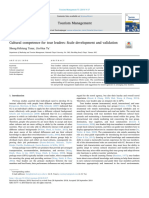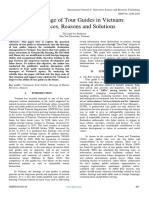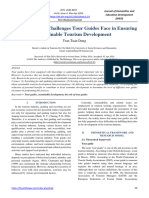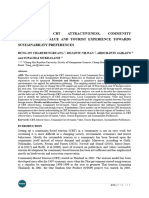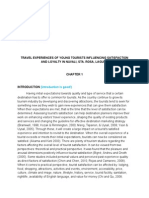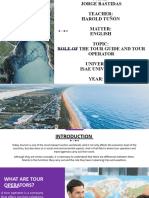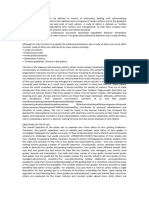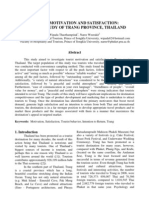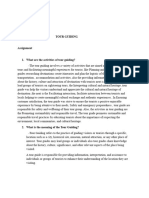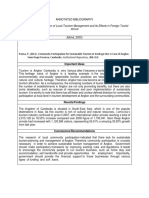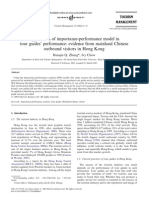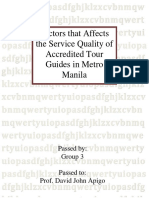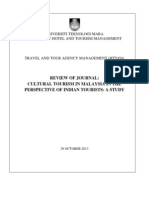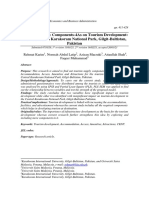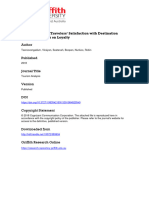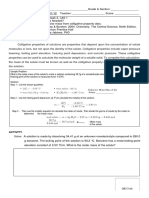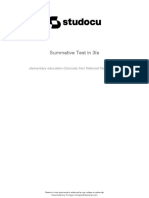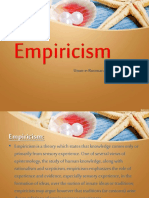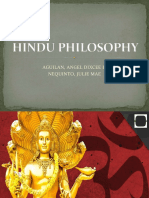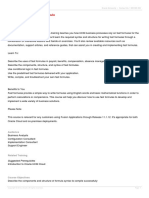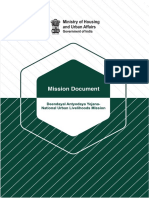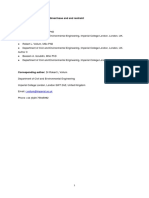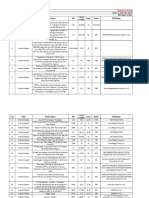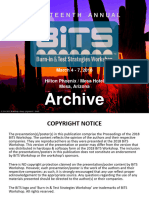Article+0102 99 104
Article+0102 99 104
Uploaded by
Fil IlaganCopyright:
Available Formats
Article+0102 99 104
Article+0102 99 104
Uploaded by
Fil IlaganOriginal Description:
Original Title
Copyright
Available Formats
Share this document
Did you find this document useful?
Is this content inappropriate?
Copyright:
Available Formats
Article+0102 99 104
Article+0102 99 104
Uploaded by
Fil IlaganCopyright:
Available Formats
TOBA (Journal of Tourism, Hospitality and Destination)
journal.literasisains.id/index.php/TOBA
ISSN Media Elektronik 2828-4100
Vol. 1 No. 2 (Mei 2022) 99-104
DOI: 10.55123/toba.v1i2.603
The Quality of Tour Guides on Tourists’ Satisfaction in Malaysia Tourism Industry
Nurul Hasanah Binti Abdul Satar 1, Ismail Halidin 2, Anggrecke Valentina Yuricka3,
Muhammad Zul Amri Izzudin4, Farida Rahmany5
Faculty of Hotel & Tourism Management, Universiti Teknologi MARA, Selangor, Malaysia
E-mail: nurul.hasanahsatar@gmail.com
ABSTRACT
Tour guides are one of the key players in the tourism industry as intermediaries between travel agents and tourists. They
have a responsibility to explain the culture and all information involving the destination. This research aims to study the
service quality of tour guides on tourist satisfaction. Empirical data were gathered from a large-scale online survey with 58
national and international tourists from Malaysia and Indonesia. The result shows that tour guides’ service quality has a
positive relationship with tourist satisfaction.
Keywords : Tour guides, Service Quality, Tourist Satisfaction, Tourism Industry, Malaysia
A. INTRODUCTION significant impact on the emotions and knowledge
A tour guide is one of the intermediaries that tourists develop following the tour (Demirovic
between travel agents and tourists therefore a tour Bajrami et al., 2020). To ensure that tourists receive
guide must have extensive knowledge related to local the promised service and fully understand the
history, culture, and tourist destinations, then be able destination, qualified tour guides must have excellent
to communicate well this aim is to convey humanistic skills and destination knowledge (S.
information to tourists well and easy to understand. Huang et al., 2010). Most tourists were dissatisfied
The importance of tour guides in the tourism industry with tour guides' performance in terms of their ability
stems from their direct interaction with tourists and to guide them (Syakier & Hanafiah, 2021). As long as
the fact that they spend more time with them than this issue persists in Malaysia, the country's
other employees in the same profession. A tour guide reputation as a desirable tourist destination will
is a person who leads groups or individual tourists suffer, as will the number of visitors and tourism
around a city or region's buildings, sites, and revenue. Therefore, this research aims to study the
landscapes, and who interprets the cultural and service quality of tour guides on tourists’ satisfaction
natural legacy in the visitor's preferred language in the Malaysia tourism industry.
(Black & Ham, 2005). Tour guides with advanced
degrees and fluency in English or another foreign B. LITERATURE REVIEW
language prefer to work. Tour Guide
Tour guides from out of town pose a threat to The definition of a tour guide is expressed in
local businesses. (Weiler & Walker, 2014) stated that many ways in the literature. A tour guide has
the role of tour guides is becoming increasingly responsible for guiding tourists during tours or
linked with sustainability issues and that tours should sightseeing. Accompany visitors, individual tourists,
contribute to changing visitors' behavior and or groups of tourists during their vacation to interpret
conservation perspectives not only on the destination historical, cultural, and natural sights in the visitor's
that they are visiting but also in their everyday language in an interesting way, explaining aspects of
situations. Due to an oversupply of tour guides, the local culture (Abd El kafy, 2021). As a guide, you
lower-priced tour services are not guaranteed to be of must have an effective combination of enthusiasm,
the same quality as higher-priced options. knowledge, personality qualities, and high standards
Furthermore, when the tourism market is still in its of conduct and ethics. A guide is someone who leads
infancy, tourists are more open to bargaining and groups to the most important sites (in our city) while
willing to compromise on the quality of a tour in also providing interpretation and commentary. Being
order to save money. Occasionally, the tour operator a tourist guide is, without a doubt, one of the most
retains a sizable portion of the package price and pays demanding professions, regardless of whether it is
the tour guide only a small portion of that done for a living or as a volunteer.
dissatisfaction will ensue if the planned activities are Tourist Guides are a resourceful group of
not completed. professionals whose vocation necessitates a diverse
Professional competencies of tour guides can range of skills, subject knowledge, and personal
be considered part of travel products because they can characteristics that are difficult to come by. Social
influence visitors' views of tour guiding service element refers to his or her responsibility tour group
quality and improve tourist satisfaction(Lin et al., unity and morale. The element of interaction is
2017). The competencies of the tour guide have a related to his function as an intermediary between his
Diterima Redaksi: 25-06-2022 | Selesai Revisi: 26-06-2022 | Diterbitkan Online: 28-06-2022
99
The Quality of Tour Guides on Tourists’ Satisfaction in Malaysia Nurul Hasanah Binti Abdul Satar1, Ismail Halidin2, Anggrecke
Tourism Industry Valentina Yuricka3, Muhammad Zul Amri Izzudin4, Farida
Rahmany5, Nur Syahirah Mohamad Ali6, Mazlina Binti Mahdzar7
party and locals, places, institutions and tourist Indeed, more research is being conducted on
facilities (Huang et al., 2010). the service quality aspect of the tour guiding
profession. For instance, (Zhang & Chow, 2004)
Service Quality of Tour Guides identified, twenty tour guide service quality attributes
Service is defined as "an action or activity that relevant to mainland Chinese tourists were identified.
can be offered by one party to another, which is The six most important attributes perceived by
essentially intangible and has no bearing on Chinese tourists were: (1) punctuality, (2) ability to
ownership." Service can be related to either a tangible solve problems, (3) knowledge of the destination, (4)
or intangible product.' Service quality denotes the honesty and trustworthiness, (5) inform safety
degree of disparity between the service provider's regulations, and (6) deliver service promised in the
expectations prior to accessing the service and the itinerary.
level of service quality (Ninpradith et al., 2018). The Likewise, (Mak et al., 2010) suggest that the
quality of the services provided by tour guides tour guide's attitude toward service (particularly in
includes their customer service approach, terms of how money-oriented or customer service-
friendliness, efficiency, and the quality of the oriented the guide is), product knowledge, and
memories tourists take away with them (Chand, 2010; communication skills are important factors in
Chen et al., 2016). Tour guides' service delivery and determining the guide's perceived service
service outcomes (e.g., friendliness, courtesy, professionalism.
efficiency, reliability, staff competency) create
service quality in the tourism industry. Travel agents Tourist Satisfaction
and the local environment of tourist attractions can Tourist satisfaction can be measured in terms
benefit from having a tour guide as a sort of neutral of expectations about the destination and the
third party. One of the most important factors in the experience, motivations or desires, activities or
tourism industry is the quality of service provided by experiences, perceptions, preferences, and
tour guides. psychological outcomes, among other things (e.g.,
A knowledgeable tour guide can help visitors Dann 1981; Iso-Ahola 1980; Lounsbury and Polik
get a better understanding of the culture and customs 1992; Manning 1986; Van Raaij 1986, 1987; Weber
of the country they're visiting. In the context of tour 1997; Williams 1988). Satisfaction with the guide
guiding, a tour guide's perceived service quality can service can be defined as “tour- ists’ overall
be assessed using three major constructs: (1) core evaluation of various services provided by tour guides
service delivery, (2) customer orientation, and (3) in a destination”(J. Huang & Hsu, 2010). Tour
effective communication (Heung, 2008). satisfaction is defined as "tour services as tourists'
Furthermore, (Heung, 2008) explains that core service affective response resulting from a cognitive appraisal
refers to the essence of a tour guide's service (e.g., of the tour operator's services"(Hwang & Lee, 2019).
follows the agreed itinerary, provides commentary, Furthermore, satisfaction with the guide service is
and ensures customer satisfaction during the tour) that directly linked to the post-consumption evaluation of
the guide must consistently deliver. Customer a service (Heung, 2008).
orientation, on the other hand , denotes the extent the
guide puts tourists’ needs and interests ahead of Tourist satisfaction is the ratio of tourists'
his/her own in providing superior value to tourists actual feelings after travelling to their expectations
(e.g. not to be focused on short-term self-interest and before travelling. Satisfaction is defined as anything
not to adopt a ‘hard’ selling approach to tourists). that can reduce human tensions, which are caused by
Communication involves the exchange of information human needs. Because satisfaction is crucial in
(e.g. communicates the itinerary/arrangement to predicting future behavioural intentions (Ninpradith
et al., 2018). Customers, according to the theory, have
tourists and handles tourists’ inquiries) and is
regarded as a crucial function of the tour guide. some level of expectation when purchasing products.
That expectation plays a significant role in
IV DV determining satisfaction and dissatisfaction. For
Service Quality of H1 Tourist example, dissatisfaction arises when service provider
Tour Guiding Satisfaction
performance falls short of expectations (also known
as negative confirmation). Unlike dissatisfaction,
Figure 1: The proposed Framework satisfaction can occur in two ways. That is,
Hypothesis 1: Tour guides’ service quality has satisfaction occurs when service provider
positive relationship with tourist satisfaction. performance meets or exceeds customers'
In this study adapt the framework of Tour expectations (also known as confirmation) (also
Guides’ Professional Competencies Influence on known as positive disconfirmation) (Hwang & Lee,
Service Quality of Tour Guiding and Tourist 2019).
Satisfaction source from Lin et, al, 2017. Figure 1 Consumers' repurchase intentions and how
show the proposed framework of the study where it they represent their purchase experience to others
relates to the aim. (word-of-mouth intentions) are all influenced by their
Lisensi: Creative Commons Attribution 4.0 International (CC BY 4.0)
100
The Quality of Tour Guides on Tourists’ Satisfaction in Malaysia Nurul Hasanah Binti Abdul Satar1, Ismail Halidin2, Anggrecke
Tourism Industry Valentina Yuricka3, Muhammad Zul Amri Izzudin4, Farida
Rahmany5, Nur Syahirah Mohamad Ali6, Mazlina Binti Mahdzar7
level of satisfaction with their purchase experience. example, if a model has seven independent variables,
Most travel operators must make concerted efforts to a regression analysis requires 50+(8)(7), or 116
improve their staff competencies and establish samples. This study only has one independent
positive relationships with their customers in order to variable so N ≥ 50+(8)(1) = 58. The respondents are
ensure tourist satisfaction (Syakier & Hanafiah, 58 people from Malaysia and Indonesia tourists.
2021). Additionally, Tourist satisfaction will be
Before answering the questionnaire,
achieved automatically once travel companies
respondents answer the screening question as follow”
provide good packages and knowledgeable tourist
Have you experienced a tour in Malaysia using tour
guides. However, the results of numerous studies
guide?”. If the respondents answered no, the survey
support the notion that consumers' level of
was terminated.
satisfaction and complaints influence their repurchase
intentions and how they represent their purchase
Analysis Methods
experience to others (word-of-mouth intentions) (Yun
et al., 2016). This study examines the service quality of tour
guides on tourist’s satisfaction in Malaysia tourism
industry. The data obtained in this study analysed
C. RESEARCH METHODOLOGY
using the Statistical Package for the Social Science
Measurement
The primary data were collected through an (SPSS) software. Quantitative data analysis is used to
online survey using google form and distributed to analyse data obtained from numbers because data
social media such as WhatsApp, Facebook, processing uses statistics, then the data must be
Instagram, etc. To empirically test the constructs in classified in certain categories to make it easier to
the proposed model, measurement items were analyse.
developed based on multi-item measurement scales Table 1: Respondents Profile
that had previously been used and validated. Service Variable N Percentage
quality was measured using 5 items cited from (Lin et Gender:
al., 2017). Tourist satisfaction was measured using 7 Male 34 58.6%
items cited from (Syakier & Hanafiah, 2021). Female 24 41.4%
Age:
Most people agree that closed questions on a Less than 20 2 3.4%
numerical Likert scale are easier for respondents to 21-30 43 74.1%
31-40 10 17.2%
answer, this study employs them. In this study, a 5- 41-50 3 5.2%
point Likert scale was used; additionally, the 5-point Above 50 - -
Likert scale offers 5 different answer options related Nationality:
to an agreement that are distinct enough for the Malaysia 26 44.8%
Indonesia 32 55.2%
respondents without confusing them. Education:
Primary/Junior High School -
The study's questionnaire had two parts: one Secondary/Senior High School 3 5.2%
with participants' demographic information and the Diploma 8 13.8%
other with their responses to the scale items of the Bachelor degree 28 48.3%
major constructs. Gender, age, marital status, Postgraduate 19 32.8%
Marital Status:
education, monthly income, and experiences on Single 33 56.9%
participate tours with tour guides. Then the scale Marriage 25 43.1%
items for the major constructs of the proposed Widowed - -
research model were included in the second section. Divorced - -
Monthly Income:
Less Than RM 1,500 / IDR 5.000.000 22 37.9%
RM 1,500 – RM 3,000 / IDR 5.000.000- 26 44.8%
Sample and Data Collection IDR 10.500.000
RM 3,100- RM 4,000 / IDR 10.500.000- 7 12.1%
After obtaining informed consent, the IDR 14.000.000
proposed research model was tested using data from a RM 4,100- RM 5,000 / IDR 14.350.000- 1 1.7%
large-scale survey collected using a convenience IDR 17.500.000
sampling procedure. Consumers and tourists who Above RM 5,000 / IDR 17.500.000 2 3.4%
Experience on Participate Tours with
have participated in tours with tour guides were Tour Guides
cordially invited to participate in this survey. Green Once 26 44.8%
(1991) proposed many approaches for determining Twice 20 34.5%
how many respondents are required for a study. Thrice 9 15.5%
Four Times - -
This study uses a quantitative method by using Above Five Times 3 5.2%
Green (1991) method in determining the sample size.
It proposed the sample size for the coefficient of
determination (R2) to be N ≥ 50+8m (where m refers
to the number of predictors in the model). For
Lisensi: Creative Commons Attribution 4.0 International (CC BY 4.0)
101
The Quality of Tour Guides on Tourists’ Satisfaction in Malaysia Nurul Hasanah Binti Abdul Satar1, Ismail Halidin2, Anggrecke
Tourism Industry Valentina Yuricka3, Muhammad Zul Amri Izzudin4, Farida
Rahmany5, Nur Syahirah Mohamad Ali6, Mazlina Binti Mahdzar7
D. FINDINGS satisfied with tour guide provides satisfactory
Response Rate and Profile information to the tourist (TS2). Other than that, the
Among the 58 respondents, 34 (58.6%) are least mean 4.07, reflects the respondent’s enjoyed the
male respondents, while the female respondents are service/package with the tour guide (TS5).
24 (41.4%). The majority of the respondents are Table 3: Descriptive Analysis- Tourist Satisfaction
between 21 and 30 years old (n = 43; 74.1%). Next, Code Items Mean Std.
most of the respondents are male (n = 34; 58.6%) Deviation
while only 24 (41.4%) are females. Furthermore, TS Tourists’ Satisfaction
most of the respondents are from Indonesia (n=32; TS1 The service that provides by 4.10 0.667
the tour guide is up to a
55.2%) while only 26 (24.8%) are Malaysian. Next satisfactory level
the majority of respondents are used tour guides for TS2 The tour guide provides 4.33 0.803
Once (n=26; 44.8%), Twice (n=20; 34.5%), Thrice satisfactory information to the
(n=9; 15%), Above four times (n=3; 5.2%). tourists
TS3 I was pleased with the outcome 4.24 0.630
Descriptive Analysis of tour guide performance
TS4 The tour guide provided a 4.12 0.727
Tour Guide Service Quality
satisfactory resolution to the
Table 2 shows the descriptive analysis for problem
Tour Guide Service Quality. From the table, the mean TS5 I have enjoyed the 4.07 0.769
score fell from 4.31 to 4.19, which indicated that services/package with the tour
most of the respondents were satisfied with the tour guide
TS6 I am delighted with the tour 4.17 0.679
guide service quality. guide services
TS7 My choice to use this tour 4.26 0.762
Looking at the table below the highest mean guide was a wise one
4.31 with reflect that the majority of respondents
agree that the tour guide can provide specific N=58, TS (tourist satisfaction)
information and friendly service (TGSQ1). Other than They delighted with the tour guide service
that, the least mean 4.19, reflects the respondent’s (M=4.17; TS6), then their choice to use this tour
moderate agreement that the tour guide’s overall guide was a wise one (M=4.26; TS7), furthermore,
service quality is satisfactory (TGSQ5). they were pleased with the outcome of tour guide
Table 2: Descriptive Analysis- Tour Guides Service Quality performance (M=4.24; TS3), The service that
Code Items Mean Std. provides by the tour guide is up to a satisfactory level
Deviation (M= 4.10; TS1), the tour guide provided a
TGSQ Tour Guide Service satisfactory resolution to the problem.
Quality
TGSQ1 The tour guide can 4.31 0.598
provide specific and Hypothesis Testing
friendly service Study variables have been analysed through
TGSQ2 The tour guide can be 4.29 0.622 simple linear regression analysis. Kumar et al. (2013)
seriously dedicated in
explanation stated that the simple linear regression is able to test
TGSQ3 The tour guide can have 4.21 0.720 the relationship of the independent variable to the
clear and organized dependent variable.
explanation.
TGSQ4 The tour guide can 4.22 0.727 Table 4: Regression analysis
immediately respond to
tourists’ needs. Predictors Hypothesis 1
TGSQ5 The tour guide’s overall 4.19 0.712 DV Tourist Satisfaction
service quality is IV Tour guide service quality
satisfactory. Std.β 0.639**
N=58, TGSQ (tour guide service quality) 0.408
Tour guide can immediately respond to tourist Adj. 0.398
need (M=4.22; TGSQ4), tour guides have clear and F-Change 38.621
organize explanation (M=4.21; TGSQ3), tour guide Table 4 reports the result of the linear regression
can be seriously and dedicated in explanation analysis. Looking at Hypothesis 1, the independent or
(M=4.29; TGSQ2). predictor: the tour guide service quality accounted for
40.8% percent (R2= 0.408; F-change = 38.621). level
Tourists Satisfaction of significance 0,000 p< 0.05. The value of (β
Table 3 shows the descriptive analysis for =.639**) indicated that the tour guide service quality
tourists’ satisfaction. From the table the mean score positively has relationship to the tourists’ satisfaction.
fell from 4.33 to 4.07, which indicate the most of In other words, the tour guide service quality
respondents were satisfied with the tour guide service influences the tourists’ satisfaction. With this, the
quality. hypothesis one (H1) is strongly supported.
Looking at the table below the highest mean
4.33 with reflect that the majority of respondents
Lisensi: Creative Commons Attribution 4.0 International (CC BY 4.0)
102
The Quality of Tour Guides on Tourists’ Satisfaction in Malaysia Nurul Hasanah Binti Abdul Satar1, Ismail Halidin2, Anggrecke
Tourism Industry Valentina Yuricka3, Muhammad Zul Amri Izzudin4, Farida
Rahmany5, Nur Syahirah Mohamad Ali6, Mazlina Binti Mahdzar7
E. CONCLUSIONS out of this study. This study might be beneficial for
According to the finding of this study, tour tour guide’s out there to know at least which type of
guide service quality positively has relationship to variables are needed to look out for when they give
tourists’ satisfaction in Malaysia tourism industry. out with their performance.
This study supports the critical part played by tour
guide performance in determining the happiness of
REFERENCE
the visitor, which in turn affects their behavioural
Abd El kafy, J. (2021). Challenges Facing Tour
intention. Therefore, the quality of tour guide on
Guide Profession and their Impacts on the
tourist satisfaction were significantly influenced by
Egyptian Guides performance. Journal of
tour guide can provide specific information and
Association of Arab Universities for Tourism
friendly service as seen in table 3 followed by tour
and Hospitality, 0(0), 0–0.
guide can be seriously dedicated in explanation, tour
https://doi.org/10.21608/jaauth.2021.54989.110
guide can immediately respond to tourists’ needs,
5
tour guide can have clear and organized explanation,
Black, R., & Ham, S. (2005). Improving the quality
and tour guide’s overall service quality is satisfactory.
of tour guiding: Towards a model for tour guide
Tour guides are representatives of their certification. Journal of Ecotourism, 4(3), 178–
workforce and tourism stakeholders due to their 195.
crucial role in the tourism system and strong https://doi.org/10.1080/14724040608668442
interaction with tourists. Their performance will have Demirovic Bajrami, D., Tretiakova, T. N.,
an impact on both the destination itself and the Syromiatnikova, Y. A., Petrovic, M. D., &
experiences of present guests. The efficiency of the Radovanovic, M. M. (2020). Tour guide’s
tour service is not only determined by the level of competencies as predictors of tourists’
knowledge that the guide possesses regarding the sustainable behavior - Evidence from national
topic at hand and the manner in which they convey parks. Geojournal of Tourism and Geosites,
this knowledge to the audience, but also by the 32(4), 1277–1282.
interaction that the guide has with the tourists from https://doi.org/10.30892/GTG.32413-569
Malaysia and Indonesia. Heung, V. C. S. (2008). Effects of tour leader’s
The study's findings add to our understanding service quality on agency’s reputation and
of how satisfied tourists are with tour guide services. customers’ word-of-mouth. Journal of Vacation
Our empirical findings further demonstrate that the Marketing, 14(4), 305–315.
level of service provided by tour guides has a https://doi.org/10.1177/1356766708094752
considerable and favourable impact on tourists’ Huang, J., & Hsu, C. H. C. (2010). The impact of
satisfaction. Tourist satisfaction will be higher when customer-to-customer interaction on cruise
tourists’ have a positive opinion of the tour guides' experience and vacation satisfaction. Journal of
services. It implies that a key element affecting Travel Research, 49(1), 79–92.
tourists' satisfaction is the quality of the service https://doi.org/10.1177/0047287509336466
provided by tour guides. Huang, S., Hsu, C. H. C., & Chan, A. (2010). Tour
guide performance and tourist satisfaction: A
The primary responsibility of tour guides is to
study of the package tours in Shanghai. Journal
lead and educate guests. They successfully connect
of Hospitality and Tourism Research, 34(1), 3–
tourists to the locations. Therefore, they should be
33. https://doi.org/10.1177/1096348009349815
skilled in guiding tour groups, including language,
Hwang, J., & Lee, J. H. (2019). Relationships among
explanation, communication, negotiation, and
Senior Tourists’ Perceptions of Tour Guides’
management, in order to introduce tourists to a good
Professional Competencies, Rapport,
journey. The role of tour guides in fostering a positive
Satisfaction with the Guide Service, Tour
perception of the location is also amply stressed in the
Satisfaction, and Word of Mouth. Journal of
tourist literature. Additionally, interaction between
Travel Research, 58(8), 1331–1346.
tour guides and visitors enhances the quality of their
https://doi.org/10.1177/0047287518803199
travel experience.
Lin, Y.-C., Lin, M.-L., & Chen, Y.-C. (2017). How
The results of this study motivate considerably Tour Guides’ Professional Competencies
more effective tour guide management through Influence on Service Quality of Tour Guiding
ongoing training because tourists today place a high and Tourist Satisfaction: An Exploratory
value on tour guide performance and quality. In order Research. International Journal of Human
to interact with tourists and foster loyalty, tour guides Resource Studies, 7(1).
must learn crucial traits such as new knowledge, https://doi.org/10.5296/ijhrs.v7i1.10602
abilities, and personalities. With this study, tour guide Mak, A. H. N., Wong, K. K. F., & Chang, R. C. Y.
needs to pay more attention on how to get the (2010). Factors affecting the service quality of
experience of customers to have higher services the tour guiding profession in macau.
quality on tourist satisfaction. Future research might International Journal of Tourism Research,
need to be conducted to validate the results that came 12(3), 205–218. https://doi.org/10.1002/jtr.746
Lisensi: Creative Commons Attribution 4.0 International (CC BY 4.0)
103
The Quality of Tour Guides on Tourists’ Satisfaction in Malaysia Nurul Hasanah Binti Abdul Satar1, Ismail Halidin2, Anggrecke
Tourism Industry Valentina Yuricka3, Muhammad Zul Amri Izzudin4, Farida
Rahmany5, Nur Syahirah Mohamad Ali6, Mazlina Binti Mahdzar7
Ninpradith, N., Viriyasuebphong, P., & owards_a_Model_for_Tour_Guide_Certificati
Voraseyanont, P. (2018). A Study of Tour on
Guide Competency, Service Quality, and https://www.cabdirect.org/cabdirect/abstract/2020349
Tourist Satisfaction of Chinese Tourist 5157
Nisachon Ninpradith. Burapha Journal of https://journals.sagepub.com/doi/10.1177/135676670
Business Management, 7(2), 106–121. 8094752
Syakier, W. A., & Hanafiah, M. H. (2021). Tour https://www.researchgate.net/publication/235651629
Guide Performances, Tourist Satisfaction And _The_Impact_of_Customer-to-
Behavioural Intentions: A Study On Tours In Customer_Interaction_on_Cruise_Experience_
Kuala Lumpur City Centre. Journal of Quality and_Vacation_Satisfaction
Assurance in Hospitality and Tourism, 00(00), https://journals.sagepub.com/doi/10.1177/109634800
1–18. 9349815
https://doi.org/10.1080/1528008X.2021.189159 https://journals.sagepub.com/doi/abs/10.1177/004728
9 7518803199
Weiler, B., & Walker, K. (2014). Enhancing the https://www.academia.edu/32585481/How_Tour_Gui
visitor experience: Reconceptualising the tour des_Professional_Competencies_Influence_on
guide’s communicative role. Journal of _Service_Quality_of_Tour_Guiding_and_Tou
Hospitality and Tourism Management, 21, 90– rist_Satisfaction_An_Exploratory_Research
99. https://doi.org/10.1016/j.jhtm.2014.08.001 https://onlinelibrary.wiley.com/doi/abs/10.1002/jtr.74
Zhang, H. Q., & Chow, I. (2004). Application of 6
importance-performance model in tour guides’ https://so01.tcithaijo.org/index.php/BJBM/article/vie
performance: Evidence from mainland Chinese w/212944
outbound visitors in Hong Kong. Tourism https://www.tandfonline.com/doi/abs/10.1080/152800
Management, 25(1), 81–91. 8X.2021.1891599
https://doi.org/10.1016/S0261-5177(03)00064- https://www.researchgate.net/publication/266561893
5 _Enhancing_the_visitor_experience_Reconcep
tualising_the_tour_guide's_communicative_rol
Sources Links: e
https://jaauth.journals.ekb.eg/article_136510.html https://www.sciencedirect.com/science/article/abs/pii/
https://www.researchgate.net/publication/249025617 S0261517703000645
_Improving_the_Quality_of_Tour_Guiding_T
Lisensi: Creative Commons Attribution 4.0 International (CC BY 4.0)
104
You might also like
- The Role of Tourist Guides and Their Impacts On Sustainable Tourism Development: A Critique On Sri LankaDocument12 pagesThe Role of Tourist Guides and Their Impacts On Sustainable Tourism Development: A Critique On Sri LankaChristy FactorNo ratings yet
- Cultural Competence For Tour Leaders - Scale Development and ValidationDocument9 pagesCultural Competence For Tour Leaders - Scale Development and ValidationRenatoGMNo ratings yet
- Examining The Effect of Tour Guide Performance, Tourist Trust, Tourist Satisfaction, and Flow Experience On Tourists' Shopping BehaviorDocument13 pagesExamining The Effect of Tour Guide Performance, Tourist Trust, Tourist Satisfaction, and Flow Experience On Tourists' Shopping BehaviorRaquel López CasadoNo ratings yet
- Tour GuidesDocument33 pagesTour GuidesgarielledumpNo ratings yet
- The Shortage of Tour Guides in Vietnam: Evidences, Reasons and SolutionsDocument5 pagesThe Shortage of Tour Guides in Vietnam: Evidences, Reasons and SolutionsInternational Journal of Innovative Science and Research TechnologyNo ratings yet
- Researching The Challenges Tour Guides Face in Ensuring Sustainable Tourism DevelopmentDocument6 pagesResearching The Challenges Tour Guides Face in Ensuring Sustainable Tourism DevelopmentPoonam KilaniyaNo ratings yet
- Effective Rapport in Tourist Guiding Interpretation of Themes 2471 8726 1000172Document5 pagesEffective Rapport in Tourist Guiding Interpretation of Themes 2471 8726 1000172amaciogabrielynNo ratings yet
- Tourists Satisfaction and Behavioral IntentionsDocument11 pagesTourists Satisfaction and Behavioral IntentionsAina ZainuddinNo ratings yet
- Models of CBT Attractiveness, Community Involvement, Value and Tourist Experience Towards Sustainability PreferencesDocument14 pagesModels of CBT Attractiveness, Community Involvement, Value and Tourist Experience Towards Sustainability Preferencesindex PubNo ratings yet
- Tourists Satisfaction at Trijuginarayan, India An Importance-Performance Analysis (#359067) - 372577Document27 pagesTourists Satisfaction at Trijuginarayan, India An Importance-Performance Analysis (#359067) - 372577Rajni KumariNo ratings yet
- Measurement of Service Quality in Hospitality Industry With Special Context To The Tourism Industry in AgraDocument18 pagesMeasurement of Service Quality in Hospitality Industry With Special Context To The Tourism Industry in AgraRajesh GurunathanNo ratings yet
- RRL DraftDocument7 pagesRRL DraftcentenopatrickdanielNo ratings yet
- Models of CBT Attractiveness, Community Involvement, Value and Tourist Experience Towards Sustainability PreferencesDocument14 pagesModels of CBT Attractiveness, Community Involvement, Value and Tourist Experience Towards Sustainability Preferencesindex PubNo ratings yet
- PERCEPTIONSSLOCALYOUNGTOURISTOFSEVICEQUALITYDocument15 pagesPERCEPTIONSSLOCALYOUNGTOURISTOFSEVICEQUALITYcintya trisantyNo ratings yet
- 1 s2.0 S2212571X16303468 MainDocument18 pages1 s2.0 S2212571X16303468 MainTrang HuyềnNo ratings yet
- Aceh Shari'a Image Destination: The Intention of Tourists To Revisit The DestinationDocument9 pagesAceh Shari'a Image Destination: The Intention of Tourists To Revisit The DestinationRahmat HidayatNo ratings yet
- Tourist Satisfaction - A View From A Mixed Internatinal Guided Package TourDocument20 pagesTourist Satisfaction - A View From A Mixed Internatinal Guided Package TourSiraj U DheenNo ratings yet
- Đề cương thảo luận TA2 - Nhóm 1Document13 pagesĐề cương thảo luận TA2 - Nhóm 1vhoaianhh19205No ratings yet
- Journal of Destination Marketing & Management: Mustafa Cevdet Altunel, Berkay ErkutDocument9 pagesJournal of Destination Marketing & Management: Mustafa Cevdet Altunel, Berkay Erkutjohanes purbaNo ratings yet
- Case Study On Tour Guiding PDFDocument13 pagesCase Study On Tour Guiding PDFNildaNo ratings yet
- 12.tourism Notes 1Document216 pages12.tourism Notes 1Karan PrajapatNo ratings yet
- Research Work Wps Office-1Document30 pagesResearch Work Wps Office-1temtop15No ratings yet
- The Study of Service Quality and Tourist Satisfaction of Rural AreaDocument19 pagesThe Study of Service Quality and Tourist Satisfaction of Rural Areaapi-513586541No ratings yet
- Lo2017 SupportDocument19 pagesLo2017 SupportMuhammad Fadil pranathaNo ratings yet
- THC Micro Module 1 and 2Document16 pagesTHC Micro Module 1 and 2Khristina Lafuente100% (1)
- NEELAB PATRAS. TDM. United KingdomDocument21 pagesNEELAB PATRAS. TDM. United Kingdomsyadirtaza505No ratings yet
- Role of GuideDocument34 pagesRole of GuidePablo AhmedNo ratings yet
- Tour Guiding: Interpreting The Challenges: Monika PrakashDocument17 pagesTour Guiding: Interpreting The Challenges: Monika Prakashsangeetha loganNo ratings yet
- Tour Guiding and Escorting ModuleDocument106 pagesTour Guiding and Escorting ModuleMikhaelaNo ratings yet
- Tour GuidingDocument3 pagesTour GuidingMalik Mohamed100% (1)
- Travel Experiences of Young Tourists Influencing Satisfaction and Loyalty in Nuvali, Sta. Rosa, LagunaDocument10 pagesTravel Experiences of Young Tourists Influencing Satisfaction and Loyalty in Nuvali, Sta. Rosa, LagunaALlyn Jane ÜNo ratings yet
- Presetation Jorge BastidasDocument10 pagesPresetation Jorge BastidasjoseantoniogriffithallenNo ratings yet
- 10 1108 - Jhti 04 2022 0149Document22 pages10 1108 - Jhti 04 2022 0149hoangngan6486No ratings yet
- Determining Adventure Tourist Loyalty - Mediating Role of Tourist Satisfaction and Quality of Life yDocument11 pagesDetermining Adventure Tourist Loyalty - Mediating Role of Tourist Satisfaction and Quality of Life ySang Nguyễn AnhNo ratings yet
- Professional Tourist Guiding The ImportaDocument11 pagesProfessional Tourist Guiding The ImportaArtania YasmineNo ratings yet
- Assessment of Tourism Service Quality For TraditioDocument19 pagesAssessment of Tourism Service Quality For TraditioPhuong QuynhNo ratings yet
- The Perceptions and Motivations That Impact Travel and Leisure of Millenial GenerationsDocument22 pagesThe Perceptions and Motivations That Impact Travel and Leisure of Millenial GenerationsMarco Ramos JacobNo ratings yet
- INTRODUCTION Ethics Can Be Defined As Branch of PH - Docx Tour GuideDocument3 pagesINTRODUCTION Ethics Can Be Defined As Branch of PH - Docx Tour GuideAl NahianNo ratings yet
- Leisure Tourism - Theory & ApplicationDocument18 pagesLeisure Tourism - Theory & ApplicationMr. roxNo ratings yet
- Tourist Motivation and Satisfaction - The Case Study of Trang Province, ThailandDocument9 pagesTourist Motivation and Satisfaction - The Case Study of Trang Province, ThailandmarlonbiuNo ratings yet
- Brief Tour GuidingDocument198 pagesBrief Tour GuidingBazezew AderawNo ratings yet
- Unit VDocument41 pagesUnit VIdk YesNo ratings yet
- IJHTH Volume 15 Issue 1 Pages 51-63Document13 pagesIJHTH Volume 15 Issue 1 Pages 51-63Mohamed TonyNo ratings yet
- 069 - Efra Sidabutar - Week 2 & 3 AssignmentDocument15 pages069 - Efra Sidabutar - Week 2 & 3 Assignmentadindarama557No ratings yet
- Tour Guide SkillsDocument6 pagesTour Guide SkillsDana AlsarawaniNo ratings yet
- JPSP - 2022 - 172Document28 pagesJPSP - 2022 - 172rioeradekaNo ratings yet
- Prototype Lesson Plan Template Travel Services W1Document6 pagesPrototype Lesson Plan Template Travel Services W1Argesil SaysonNo ratings yet
- Tour GuidingDocument4 pagesTour GuidingFLORENCE DE LEONNo ratings yet
- The Relevance of Motivation Authenticity and Destination Image To Explain Future Behavioural Intention in A UNESCO World Heritage SiteDocument25 pagesThe Relevance of Motivation Authenticity and Destination Image To Explain Future Behavioural Intention in A UNESCO World Heritage SiteAndrea ArredondoNo ratings yet
- Annotated Bib..Document5 pagesAnnotated Bib..Whotfis MaysieNo ratings yet
- 4.Management-Tour Guides - Are They Tourism Promoters and Developers - James MalitonDocument18 pages4.Management-Tour Guides - Are They Tourism Promoters and Developers - James MalitonImpact JournalsNo ratings yet
- Group Assignment PDFDocument44 pagesGroup Assignment PDFshhhhhhh.33333hdhrNo ratings yet
- Marketing of Tourism Services - Methods, Measurement and Empirical AnalysisFrom EverandMarketing of Tourism Services - Methods, Measurement and Empirical AnalysisNo ratings yet
- Tour Guide InstrumentDocument11 pagesTour Guide Instrumentanon-826661100% (1)
- 1-s2.0-S2211973618301089-mainDocument9 pages1-s2.0-S2211973618301089-mainAqtabNo ratings yet
- Factors That Affects The Service Quality of Accredited Tour Guides in Metro ManilaDocument31 pagesFactors That Affects The Service Quality of Accredited Tour Guides in Metro ManilaMerlito BabantoNo ratings yet
- Cultural Tourism in MalaysiaDocument4 pagesCultural Tourism in MalaysianisabuckNo ratings yet
- Impact of Supply Components-4As On Tourism Development - Case of Central Karakoram National Park, Gilgit-Baltistan, PakistanDocument14 pagesImpact of Supply Components-4As On Tourism Development - Case of Central Karakoram National Park, Gilgit-Baltistan, Pakistanahmad ishfaqNo ratings yet
- The Influence of Travelers SatisfactionDocument5 pagesThe Influence of Travelers Satisfactionpz4zthgh4nNo ratings yet
- The Ultimate Career Guide in The Tourism and Hospitality Industry: one call, #1From EverandThe Ultimate Career Guide in The Tourism and Hospitality Industry: one call, #1No ratings yet
- Week 3 First Law of ThermodynamicsDocument4 pagesWeek 3 First Law of ThermodynamicsFil IlaganNo ratings yet
- Week 2 Properties OfsolutionsDocument4 pagesWeek 2 Properties OfsolutionsFil IlaganNo ratings yet
- Week 4 Reaction RatesDocument4 pagesWeek 4 Reaction RatesFil IlaganNo ratings yet
- Summative Test in 3is Summative Test in 3isDocument4 pagesSummative Test in 3is Summative Test in 3isFil IlaganNo ratings yet
- GRADE 12 - Print Players - QuizizzDocument22 pagesGRADE 12 - Print Players - QuizizzFil IlaganNo ratings yet
- Civil Service?: What Is It?Document236 pagesCivil Service?: What Is It?Fil IlaganNo ratings yet
- Grading SystemDocument20 pagesGrading SystemFil IlaganNo ratings yet
- MS AccessDocument24 pagesMS AccessFil IlaganNo ratings yet
- Item AnalysisDocument16 pagesItem AnalysisFil IlaganNo ratings yet
- Empiricism: Umm-e-Rooman YaqoobDocument23 pagesEmpiricism: Umm-e-Rooman YaqoobFil IlaganNo ratings yet
- Aguilan, Angel Dixcee L. Nequinto, Julie MaeDocument10 pagesAguilan, Angel Dixcee L. Nequinto, Julie MaeFil IlaganNo ratings yet
- EverdigmDocument40 pagesEverdigmOrhan HasanogluNo ratings yet
- VentilatorDocument15 pagesVentilatorMohamedNo ratings yet
- Public Register 2020 PDFDocument388 pagesPublic Register 2020 PDFNuriman JaafarNo ratings yet
- How To Write Good Test Cases PDFDocument4 pagesHow To Write Good Test Cases PDFMamatha K NNo ratings yet
- Skim Coat Work Progress-Layout1Document1 pageSkim Coat Work Progress-Layout1moh amohNo ratings yet
- Astm D3080 PDFDocument9 pagesAstm D3080 PDFJhun Castro100% (2)
- IEC Law Seminar Week 11 - Preliminary References 1 202223Document3 pagesIEC Law Seminar Week 11 - Preliminary References 1 202223nneoma kengoldenNo ratings yet
- Reinventing Productivity ShortDocument8 pagesReinventing Productivity ShortAgusNo ratings yet
- ......................... . v. ......................................................... RespondentDocument14 pages......................... . v. ......................................................... RespondentParikshit ShuklaNo ratings yet
- Oracle HCM Cloud: Fast Formula: DurationDocument3 pagesOracle HCM Cloud: Fast Formula: DurationWilliam LeeNo ratings yet
- History of NDMCDocument20 pagesHistory of NDMCChikoy Xhi100% (1)
- Kivy LatestDocument932 pagesKivy LatestArnau GàmezNo ratings yet
- 2022 S C M R 2123Document6 pages2022 S C M R 2123Urooj LashariNo ratings yet
- Peter Debbins Court FilingDocument20 pagesPeter Debbins Court FilingChuck RossNo ratings yet
- File 1428726206Document8 pagesFile 1428726206Rizwanahmad Khan Rizwanahmad KhanNo ratings yet
- Telangana State Policies (English)Document29 pagesTelangana State Policies (English)deepakk047No ratings yet
- Building Your Company's VisionDocument14 pagesBuilding Your Company's VisionVikasdeep SharmaNo ratings yet
- Signal Spectra, Signal ProcessingDocument16 pagesSignal Spectra, Signal ProcessingJc Bernabe Daza100% (1)
- NULM Mission DocumentDocument38 pagesNULM Mission DocumentChouhan Akshay SinghNo ratings yet
- HXHM4XWW21032T0ADocument1 pageHXHM4XWW21032T0AHanna BezrukavaNo ratings yet
- Chapter 9-Strategic ManagementDocument26 pagesChapter 9-Strategic ManagementshahjahansiddikibipulNo ratings yet
- The Fundamentals of Writing CDR ReportDocument3 pagesThe Fundamentals of Writing CDR Reporttavovalencia100% (5)
- Loctite 2440™: Technical Data SheetDocument3 pagesLoctite 2440™: Technical Data SheetFabio ParceroNo ratings yet
- Shunt ReactorDocument6 pagesShunt ReactorvinaykumaarNo ratings yet
- PROFED9-Midterm-ReviewerDocument4 pagesPROFED9-Midterm-ReviewerToledo Cristine JadeNo ratings yet
- COB Media ListDocument8 pagesCOB Media ListRogerRayappanNo ratings yet
- Cracking in Walls With Combined Base and Edge Restraint - Authors' VersionDocument28 pagesCracking in Walls With Combined Base and Edge Restraint - Authors' VersionAd FwyNo ratings yet
- Balance Foraward 01-11-2023Document56 pagesBalance Foraward 01-11-2023cancer0113681No ratings yet
- System Level TestDocument22 pagesSystem Level TestTulja AmatyaNo ratings yet
- McGraw Transit DirectoryDocument287 pagesMcGraw Transit DirectoryDe'Von JNo ratings yet

